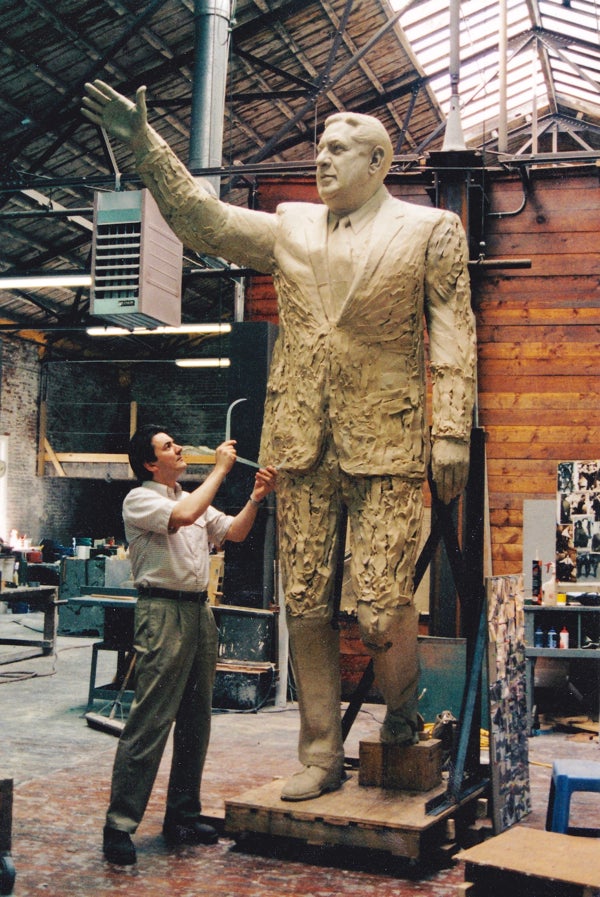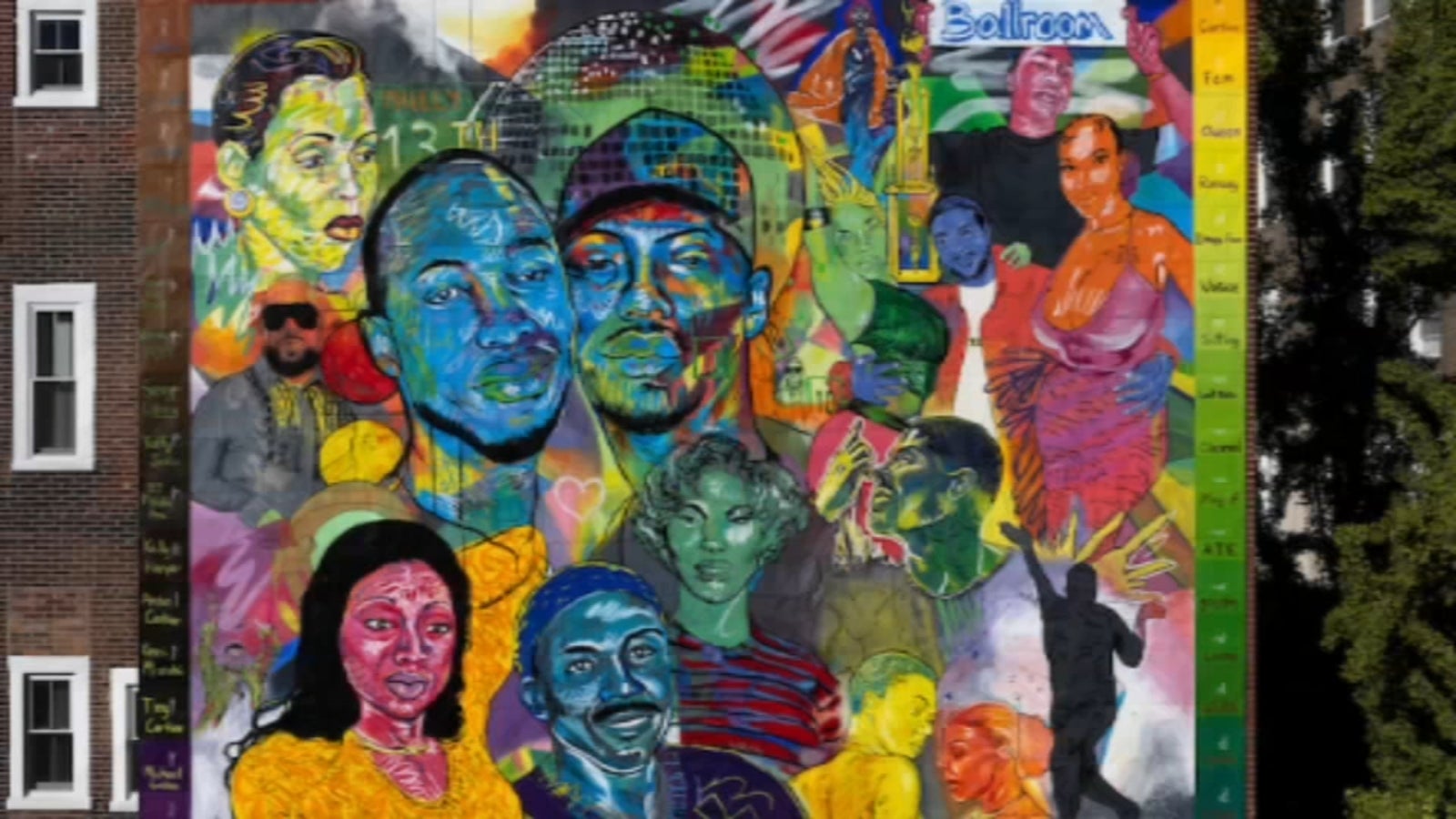On furor over Rizzo statue, sculptor Zenos Frudakis says, ‘Let’s talk about it’
Listen 2:41
The statue of former Philadelphia Mayor Frank Rizzo drips with egg in this August 2017 file photo. Last summer, the statue was increasingly the target of vandals and protesters who see it as a symbol of racism. (Emma Lee/WHYY)
Of more than 250 sculptures scattered around Philadelphia, none has sparked as much controversy as that of the late mayor and police commissioner Frank Rizzo whose bronze likeness waves hello to City Hall and its visitors as it descends the steps from Thomas Paine Plaza.
Critics unhappy with Rizzo’s record on police brutality, especially in communities of color, have called for its removal in recent years, with some protesters even putting a Ku Klux Klan hood and bikini on it.
Police have grown so vigilant about vandalism that they put metal barricades around it Wednesday morning, in preparation for an evening march against racism organized after last weekend’s deadly violence in Charlottesville, Virginia.
Such police protection didn’t deter one vandal, who chucked a few eggs at the statue Wednesday and was quickly caught by officers tasked with babysitting the statue. The 25-year-old Maplewood, New Jersey, suspect was charged with disorderly conduct and criminal mischief.
As the outcry mounted, WHYY reporter Joe Hernandez checked in with sculptor Zenos Frudakis, who created the Rizzo statue and helped erect it in 1998.
The following interview has been edited for clarity and length.
Q: The furor nationally over Confederate statues in the South has heightened efforts in Philadelphia to remove the Rizzo statue, which some see as the most objectionable public art here. As its creator, how does that make you feel?
A: There were some calls about the Rizzo statue earlier, that it was disturbing to some people because he was considered really racially polarizing. I came here from Gary, Indiana, in 1972 to go to the Pennsylvania Academy of the Fine Arts, so I was here when he (Rizzo) started as mayor. He served from 1972 through 1980, two terms. I was an art student, a very liberal art student.
I’m still liberal, socially conscious and doing all these pieces, the Freedom Sculpture and the King sculpture and all the things that I’ve done. When this came in, I was very concerned, because I didn’t vote for him. I had met him. It was a commission. I had to think about it, because I didn’t have a career yet. I didn’t have any work. It’s one of those things where you think, “What do I do?”
Since then, I have turned down doing sculptures of presidents that I didn’t want to sculpt and lost a lot of money for it. But I could afford it. Sometimes, ethics are more affordable than other times.
Q: So sculpting Rizzo helped pay your bills.
A: I didn’t get paid that much. I got paid for the Rizzo. It was a decent paying job. It wasn’t 30 pieces of silver.
Q: It was more about moving ahead in your career?
A: I think it was part of it. Let’s say, if you’re an actor, if you don’t get a job on stage, you don’t get to apply your trade. No one knows how good you are. You have to exercise your trade to get better, and it’s very difficult, in this city, there were people running the arts program that didn’t like figurative sculpture. So when work comes, I have to sort of be aggressive about taking it sometimes. I was really just an artist doing a job for the most part.

Q: How do you feel about critics who see Rizzo as Philadelphia’s version of a Confederate statue — so objectionable that it must be torn down?
A: I don’t like the idea of Rizzo being associated with Southern generals that were traitors. I don’t think that’s a fair equation. I personally think Trump is an illegitimate president. Watching him Tuesday (discuss the Charlottesville violence), I think he’s criminally insane. I think he’s a psychopath. I think he’s a narcissistic, schizophrenic individual with delusions of grandeur. The thing about Washington and Jefferson being slave owners and all that Trump mentioned, yes, that’s true. But these Southern generals were trying to destroy the country that Washington and Jefferson created.
In Germany, they outlawed the swastika and Nazi stuff. I think they should outlaw it here. Yes, free speech, but you can’t yell fire in a theater. It’s going to cause people to get hurt. People have died over Nazi symbols, just as they have over rebel flags. Both are traitorous.
Q: So, what should be done about the Rizzo statue?
A: There are a couple of solutions here. One is to remove them. As a sculptor, I’m concerned, because some of those (controversial) pieces were well done by good sculptors. Some of them are pretty good works of art, but the subject matter now is cause for concern. It is for me too.
Have you been to Budapest?
Q: No.
A: In Budapest, they have a very large park where they dumped a lot of sculptures of Russian propaganda. Some of them are really well done. They didn’t destroy them. They isolated them. So people know they’re coming to see them, and they’re part of an illegitimate past. They lose their legitimacy by being in a not-special place.
The other things you can do it to reappropriate them. For example, put something around it. Instead of spending (millions of dollars) like they did to take down the one in New Orleans, maybe you take that money and put something around the statue that educates people. You redefine it. Have something like the Catto sculpture nearby. You can put sculptures around it of African-Americans, and put up a plaque explaining why he was controversial. Make it a piece of education.
If you remove it, the education is gone. I remember (a Rizzo-era controversy about police) lining up some Black Panthers and publicly strip-searching them. I’m not saying you have to have a statue of naked Black Panthers beside Rizzo. But I made him look like Augustus Caesar. And I did it deliberately. Even though I wasn’t in favor of him, I still did the best job I could because I’m an artist. I made him look good. As an artist, I have to do the best job I can.
Q: How did you decide how to portray Rizzo?
A: I wanted him to look like a politician. He’s waving to the crowd. If you look at Augustus Caesar and other leaders, that wave is there. Politicians have been doing that for a very long time. Probably cavemen did it, even before that, saying: ‘Vote for me, and we’ll have a safe cave, and keep the saber-tooth tigers from the door!’ as they waved at the crowd.
It’s universal. (Rizzo’s son) Frank Rizzo Jr. (and a few others) came to me. They were all very nice to me. They came in, and Franny gave me a big box of Rizzo photographs. I always like to have a lot of photos for research. He said,”Pick out the photograph that you think represents my father. How do you see him?”
I went through all these photos. I pulled out a photo of him walking down Benjamin Franklin Parkway on St. Patrick’s Day, waving to the crowd. And he said, “‘That’s the same picture I picked, out of those 200, and that’s the same picture my mother picked.”
Q: How should the city handle critics’ calls for the statue to be taken down?
A: I think there should be conversation. I don’t think people should rush. What sculpture do we have of somebody who is flawless? The day he died, he had gone to an African-American church to talk. Cynically, one could say he was doing that because he knew he needed their votes. I don’t know his heart. But I like to think he was growing and thinking, “I can reach out more.”
He had an African-American driver. A lot of policemen were black; they weren’t all white. It’s a little complicated. It’s not all black and white. There’s a lot of gray here.
Should he be front and center across from City Hall? Well, that’s something people should talk about. Rizzo got elected twice by a majority of people in Philadelphia — and he probably would have gotten elected a third time if he hadn’t died. But if the majority now would prefer to see him somewhere else, maybe a nice park in South Philly, that’s something we can talk about. I’d love to do a King sculpture there (to replace him).
Q: Do you regret sculpting Rizzo?
A: Sometimes. If I had been asked then to sculpt Robert E. Lee, I probably would have done it. I would’ve said, “OK, I want to compete with that, let me see what I can do.”
But today, I wouldn’t do it. I wouldn’t sculpt Trump. I spent five years on that piece.
Q: On Rizzo?
A: Yeah, it was off and on. They were raising money. I worked on it in my studio for a while and then moved it to the bronze foundry and decided it was a little short, so I cut it in half and raised it a little and added a few inches in there, because it looked a little too stocky. It’s a big piece, it’s 10 feet tall.
When you met him (Rizzo), he had a big presence. He had this barrel chest – it felt like he could knock you over with his chest if he confronted you. He was a very big man, and I wanted to get that quality there. I gave it decorum and dignity, and I think it’s very alive looking. That’s what I wanted to do. I’ve done over 100 bronze statues that are life-size or larger.
I have done a lot of 10-foot statues like Rizzo. I did all four of the Phillies statues that are over 10 feet.
Q: What would removing the statue require?
A: When I put that sculpture in, I put it in to be there permanently. You’d have to break up a good part of that stairway. That stone would have to be hammered to bits. Normally, you’d have a granite base, and you’d drill holes, and have probably seven inches coming out of each leg going into the ground, and an epoxy.
But, with this one, we’ve got a bronze base that’s welded to it that we had to put it in because there’s a subway station underneath. It’s installed in a way that would make it very difficult not to damage the sculpture, the steps, and everything around it.
But let’s have that discussion. Maybe we should look at every piece that’s up. I personally think the first sculptures that should be removed are the ones that are not done well. But then who gets to pick? I don’t like incompetence. If I hear music and people are hitting the wrong notes, I don’t want to hear it. And I feel that way about figurative sculpture, in particular.
WHYY is your source for fact-based, in-depth journalism and information. As a nonprofit organization, we rely on financial support from readers like you. Please give today.




